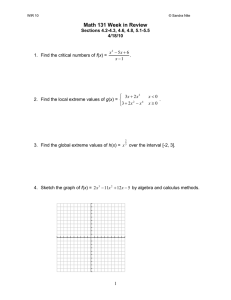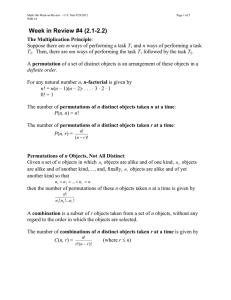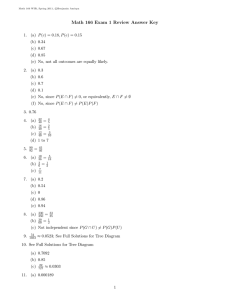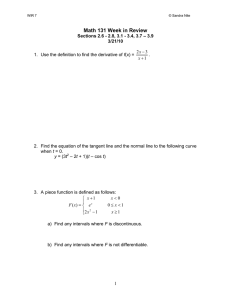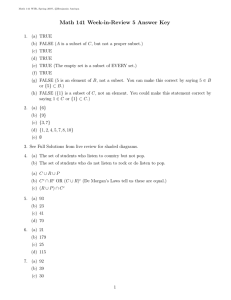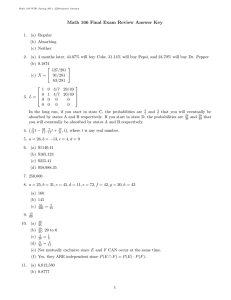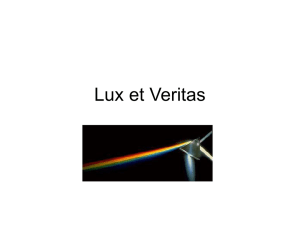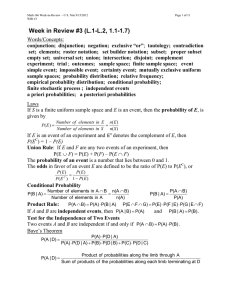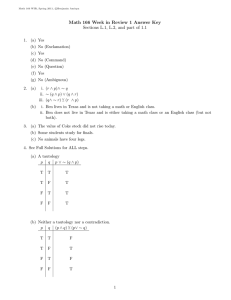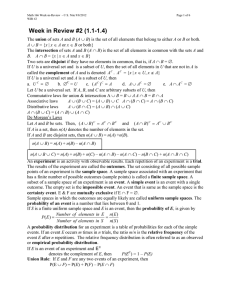Week in Review #1
advertisement
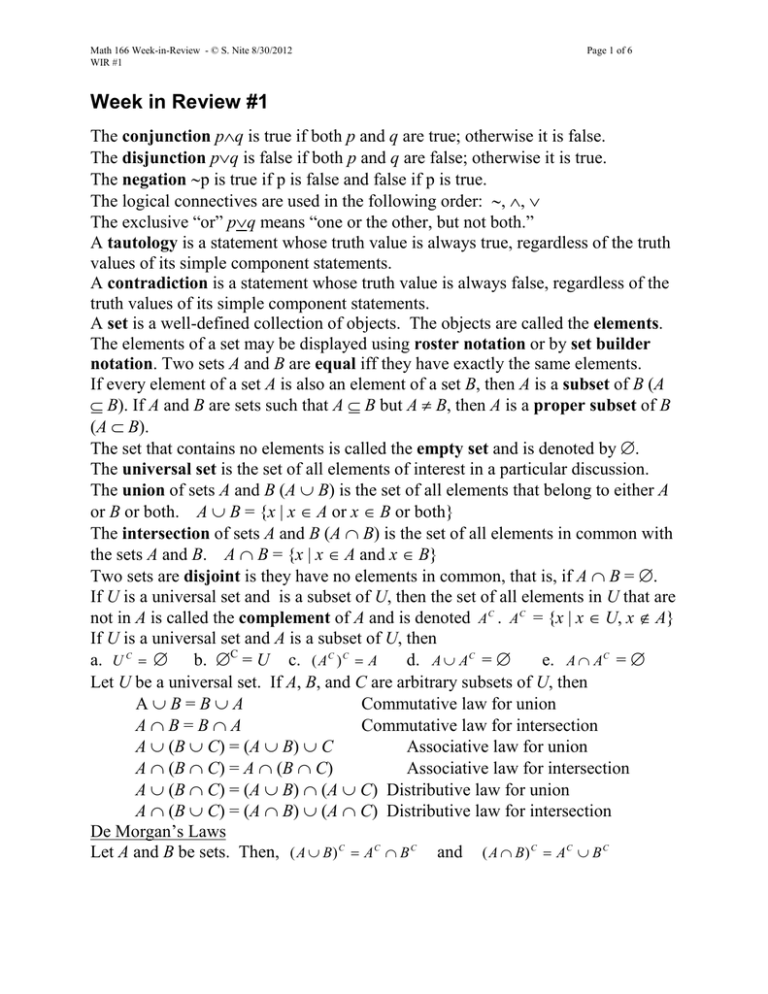
Math 166 Week-in-Review - © S. Nite 8/30/2012
WIR #1
Page 1 of 6
Week in Review #1
The conjunction p∧q is true if both p and q are true; otherwise it is false.
The disjunction p∨q is false if both p and q are false; otherwise it is true.
The negation ∼p is true if p is false and false if p is true.
The logical connectives are used in the following order: ∼, ∧, ∨
The exclusive “or” p∨q means “one or the other, but not both.”
A tautology is a statement whose truth value is always true, regardless of the truth
values of its simple component statements.
A contradiction is a statement whose truth value is always false, regardless of the
truth values of its simple component statements.
A set is a well-defined collection of objects. The objects are called the elements.
The elements of a set may be displayed using roster notation or by set builder
notation. Two sets A and B are equal iff they have exactly the same elements.
If every element of a set A is also an element of a set B, then A is a subset of B (A
⊆ B). If A and B are sets such that A ⊆ B but A ≠ B, then A is a proper subset of B
(A ⊂ B).
The set that contains no elements is called the empty set and is denoted by ∅.
The universal set is the set of all elements of interest in a particular discussion.
The union of sets A and B (A ∪ B) is the set of all elements that belong to either A
or B or both. A ∪ B = {x | x ∈ A or x ∈ B or both}
The intersection of sets A and B (A ∩ B) is the set of all elements in common with
the sets A and B. A ∩ B = {x | x ∈ A and x ∈ B}
Two sets are disjoint is they have no elements in common, that is, if A ∩ B = ∅.
If U is a universal set and is a subset of U, then the set of all elements in U that are
not in A is called the complement of A and is denoted A C . A C = {x | x ∈ U, x ∉ A}
If U is a universal set and A is a subset of U, then
d. A ∪ AC = ∅
e. A ∩ AC = ∅
a. U C = ∅ b. ∅C = U c. ( A C ) C = A
Let U be a universal set. If A, B, and C are arbitrary subsets of U, then
A∪B=B∪A
Commutative law for union
A∩B=B∩A
Commutative law for intersection
A ∪ (B ∪ C) = (A ∪ B) ∪ C
Associative law for union
A ∩ (B ∩ C) = A ∩ (B ∩ C)
Associative law for intersection
A ∪ (B ∩ C) = (A ∪ B) ∩ (A ∪ C) Distributive law for union
A ∩ (B ∪ C) = (A ∩ B) ∪ (A ∩ C) Distributive law for intersection
De Morgan’s Laws
Let A and B be sets. Then, ( A ∪ B) C = A C ∩ B C and ( A ∩ B) C = A C ∪ B C
Math 166 Week-in-Review - © S. Nite 8/30/2012
WIR #1
Page 2 of 6
1. Which of the following are statements?
a. Texas A&M is the best university.
b. Texas is the largest state in the USA.
c. What time is it?
d. 3 + x = 5
e. 4 + 9 = 13
f. Houston is the fourth largest city in the USA.
2. Consider the following statements:
p: The book is used.
q: The book is green.
r: The book is about math.
a. Express the statement ∼ r ∨ (p ∧ r) in words.
b. Express the statement ∼ ( q ∧ p) ∨ r in words.
c. Express the statement “The book is green and new” symbolically.
d. Express the statement “The book is a new blue English book or a used
green book” symbolically.
e. Write the negation of q in words.
Math 166 Week-in-Review - © S. Nite 8/30/2012
WIR #1
Page 3 of 6
3. Construct truth tables for the following compound statements. Indicate whether
each compound statement is a tautology, a contradiction, or neither.
a. q ∧ (∼ p ∨ q)
p
q
b. ∼( p ∨ q) ∨ (p ∧ q)
p
q
c. (∼ q ∨ r) ∨ ∼ (p ∧ r)
p
q
r
Math 166 Week-in-Review - © S. Nite 8/30/2012
WIR #1
Page 4 of 6
4. Consider the following statements.
p: 4 + 3 = 7
q: 15 × 2 = 32
r: 17 – 9 = 8
Determine the truth value of the following compound statements.
a. q ∧ (∼ p ∨ q)
b. (∼ q ∨ r) ∨ (p ∧ r)
5. Refer to the Venn diagram to find the number of elements in each of the
indicated sets.
U
A
75
40
95
B
90
a. A
b. ( A ∪ B) C
c. A C ∩ B C
d. A C ∩ B
Math 166 Week-in-Review - © S. Nite 8/30/2012
WIR #1
Page 5 of 6
6. Given n(A) = 80, n(B) = 50, n(A∩B) = 20, n(U) = 200, find
a. n( A ∩ B C )
b. n( A C ∩ B )
c. n( A C ∩ B C )
7. A survey of 1,200 people in a certain city indicates that 850 own microwave
ovens, 740 own VCR’s, and 580 own microwave ovens and VCR’s.
a. How many people in the survey own either a microwave oven or a VCR?
b. How many own neither a microwave oven nor a VCR?
c. How many own a microwave oven and do not own a VCR?
8. Shade the portion of the figure that represents the set (A ∪ C) ∩ B.
U
B
A
C
Math 166 Week-in-Review - © S. Nite 8/30/2012
WIR #1
Page 6 of 6
9. Let U = {1, 2, 3, 4, 5, 6, 7, 8, 9, 10}, A = {1, 3, 5, 7}, B = {2, 4, 6, 8}, and C =
{1, 4, 7, 8, 9}. Find ( A ∪ C ) ∩ B c
10. Let U denote the set of all students in the science college of a certain
university. Let
A = {x ∈ U | x had taken a course in Mathematics}
B = {x ∈ U | x had taken a course in Biology}
C = {x ∈ U | x had taken a course in Chemistry}
Write the set that represents the statement “The set of students who have had
courses in Mathematics and Chemistry but not Biology.”
